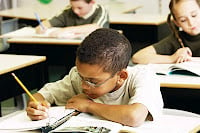
Before I joined NFIs staff, I never heard of the term "father absence," but I was most certainly a product of it.
Raised by a single, African-American mother in a tough neighborhood, I had to navigate the dangers of my environment and still be a well-behaved student. My mother worked late five days a week, and I was left alone often. Naturally, I modeled my behavior after the tough guys in the neighborhood, carrying that attitude into school. I was in trouble frequently for insubordination and not following instructions. Mom attributed much of my actions to my father not being around to help guide me.
A
national survey conducted by the Department of Educations
Office of Civil Rights (OCR) points to a glaring gap between the discipline students of color faced compared to their white counterparts. The numbers showed that while the collected data counted for just 18 percent of African-American students, Black males were shown to have nearly twice as many suspensions and even higher numbers for expulsion.
According to
recent reports compiled using Census data and other sources, it was found that last year just 33 percent of Black children lived in a two-parent household compared to 85 percent of Asian children, 75 percent of White children and 60 percent of Hispanic children. Nearly all children living in single-parent homes lived with their mothers, with over half of those being Black children.
While the OCR survey is said to be expanding its research categories in the ongoing survey, it hasnt been said to include data regarding the number of parents in the home. Education Secretary Arne Duncan addressed reporters in an open call on Monday ahead of the release of the data, asserting that the numbers are not directly a result of discrimination. Educators, obviously invested in what the data means ultimately, wisely noted that race, poverty and struggling school districts plays a part in whats happening.
I scoured a lot of text while writing this blog entry, and not one person mentioned the family structure, at least in my searches. There is nothing said on whether these students of color are in two-parent homes or not. According to research, children from father-absent homes are more like to have behavioral problems. Why are commentators ignoring this reality?
In my own experiences, not having my father present in the home directly impacted how I behaved when I was not under my mothers care. Im not a statistician or researcher, but other numbers mesh with this report. 24 million children live apart from their biological fathers, with two out of three Black children and one of three Hispanic children dealing with father absence.
That alone points to something Id like to see the OCR address in their further collection of data. While its not the Department of Educations aim to offer a counter to the problem of father absence, Im a living example of how the issue of academic failure could also be attributed to growing up in an unbalanced home environment.
Regardless of race and other societal factors, you cant always expect well-behaved children in the face of father absence. In fact, the more the gap widens between fathers and children, the more we can expect numbers like this to spike even higher, and thats truly a shame.